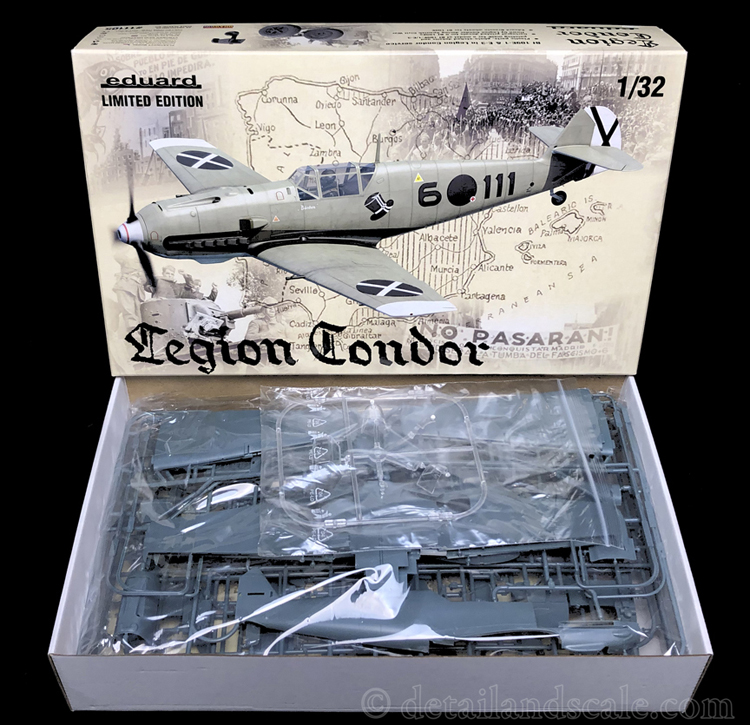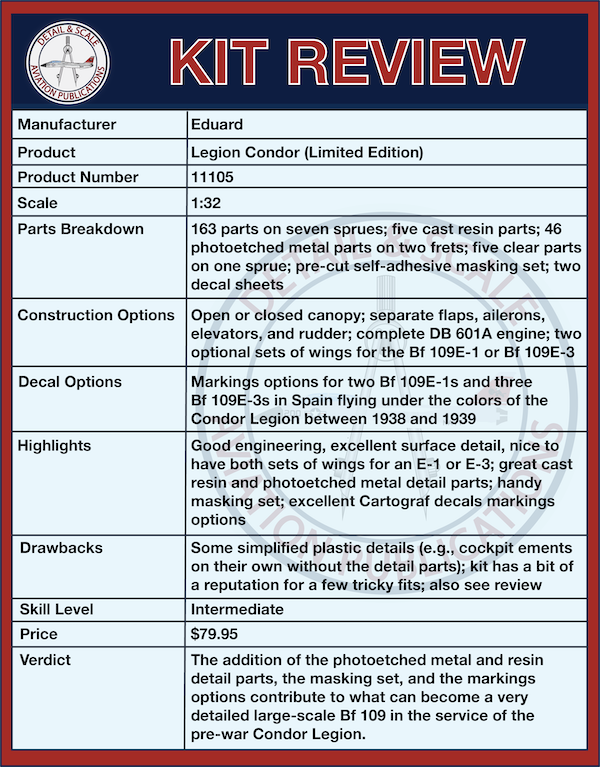Eduard Legion Condor (Limited Edition) — 1:32 Scale


The Messerschmitt Bf 109 will forever be associated with the Second World War and the Luftwaffe, but the airplane saw its introduction to combat over the skies of Spain during the Spanish Civil War. In this review, we take a look at look at Eduard’s recent limited edition release called Legion Condor that features their 1:32 scale Bf 109E kit accompanied by cast resin and photoetched metal parts, a masking set, and decals for two Bf 109E-1s and three Bf 109E-3s that served during that conflict.

The Bf 109 was one of the two premier single-seat German fighters of the Second World War. The prototype flew in 1935, beating out the predecessor of the Fw 190. The entire 109 production run churned out 33,984 airframes spanning dozens of variants and subtypes. In the mid-1930s, it was the most advanced fighter of its era, featuring an all-metal monocoque construction, a closed canopy, and retractable landing gear. As a testament to the versatility and capability of the basic design, Bf 109s were still deadly opponents ten years later when the war came to a close as jet fighters came onto the scene. Indeed, Bf 109s flew on for years to come with the IAF, the Swiss and Czech air forces, and Spain flew them the longest operating the type until 1967.
The E-model Bf 109 was a developmental progression on the ideas and designs fielded in the C- and D- models. The E-, nicknamed the “Emil,” featured the first major redesign of the original 109 to that point. Many of the changes related to a new powerplant. The larger, longer, and more powerful Daimler-Benz DB 601A increased the 109’s top speed by 60 miles per hour and its service ceiling by nearly 5,000 feet. The DB 601 engine used direct fuel injection that provided excellent performance in negative-G flight. This engine required bigger radiators, and the best (least drag-inducing) place to put them was under the wings. This required a significant redesign, from structural wing elements to the inclusion of radiator ducting under the skin. The Bf 109E-3 sported heavier armament than its predecessors with two MG 17s above the engine, one MG FF cannon shooting through the propeller hub, and one MG FF cannon in each wing. The more lightly armed E-1 and heavier armed E-3 were produced in parallel beginning in 1939.
The Spanish Civil War erupted in the wake of a July 1936 coup. The horrific brutality of this conflict in many ways foreshadowed what was to soon sweep across Europe during WWII. The Nationalists requested military support from Hitler and Mussolini. German involvement was initially quite covert. The air elements came together as the Condor Legion (or Legion Condor in Spanish) that served under the Nationalists. Beyond the fact that Hitler found a sympathetic ally in Franco and the strategic promise of a friendly fascist Spain, the Condor Legion was to serve as a proving ground for Luftwaffe technology, tactics, and operational procedures before the Nazi expansion across Europe. These included the development of air combat tactics and methods of strategic bombing. One of the most infamous episodes involved the bombing of the Basque town of Guernica that killed up to 1,600 civilians. Some 130 Bf 109s, spanning A- thru E- variants, made their way to Spain. They went up against Soviet-supplied aircraft flown by Spanish Republican forces beginning in 1937. The Republican Polikarpov I-15 and I-16s were superior to the Heinkel He 51 biplane which was the first German fighter used by the Nationalists in theater. When the Bf 109 came on the scene, the tables turned, and the Polikarpovs were no match and suffered devasting losses. Nearly 50 Bf 109s remained with the Spanish Air Force after the conclusion of the civil war in 1939.

Eduard’s limited edition kit, Legion Condor, contains their 1:32 scale Bf 109E that features 163 injection molded parts on seven dark blue-grey sprues (about 22 parts go unused in this version of the kit), five clear parts on one clear sprue, 46 photoetched metal parts on two frets (about half of them are pre-painted), five cast resin parts, a small pre-cut masking set for the windscreen and canopy, and two decal sheets. The decals cover the following five airframes:
- Bf 109E-1, flown by Oblt. Hans Schmoller-Haldy, 3.J/88, Spain, 1938
- Bf 109E-1, flown by Oblt. Siebelt Reents, 1.J/88, Leon, Spain, Spring 1939
- Bf 109E-3, 2.J/88, Catalunyan Front, Spain, early 1939
- Bf 109E-3, flown by Uffz. Herbert Schob, 3.J/88, Barcience, Spain, March 1939
- Bf 109E-3, flown by Lt. Werner Ursinus, 2.J/88, La Cenia Spain, 1939
Strengths: The 1:32 Bf 109E from Eduard goes back a bit to initial tooling developed in 2009. It has a reputation as being a little fiddly to build – their new tool 1:48 scale Bf 109s feature better fit and ease of construction (at least, so says the word on the street, from three people who I have grilled who have built these). As always, take your time, dry-fit, and follow the instruction sequence carefully.
The kit features very nice recessed panel lines and fastener/rivet details. It is essentially on par with current Eduard products. There are a range of construction options, including the positionable canopy, separate leading-edge slats, flaps, ailerons, elevator, and rudder. The control surfaces have mounting tabs that essentially force them into a neutral position, but a few swipes of a knife and sanding stick will allow the scale modeler to position them in any way they wish. There is also a complete Benz DB 601A engine on the sprues and the complete dual nose guns. Note that there are two sets of wings – one for the Bf 109E-1, and the other for the more heavily armed Bf 109E-3 with the underwing bulged fairings for the MG FF cannons. Build accordingly to your desired markings option.
The kit cockpit on its own is a little…blah. The detail is okay for injection molding, but it is also somewhat underwhelming. A part of me thinks Eduard does that intentionally so as to drive most builders towards their aftermarket parts, but most of us don’t mind. It’s a rational strategy! Here, those aftermarket parts are in the box, and they are awesome. When you use these photoetched metal instrument panel parts, belts, and other items, you will elevate the kit cockpit to an entirely new level. The photoetched parts are also just perfectly made, including the great pre-painted instrument panel details and pilot restraints. However, if PE metal parts aren’t your thing, an instrument panel decal is provided. The optical quality of the clear parts is excellent. The canopy is of the early-style Erla design. The cast resin main wheels and tail wheel well are excellent and far superior to the kit parts. The tire details themselves are gorgeous.
The decals are printed by Eduard and look great, with excellent color, resolution, and thin, restrained carrier film. There’s a correction insert for the Condor Legion aircraft insignia, as the main decal sheet appears to have printed them somewhat under-sized. The kit comes with various schemes to choose from. While the colors are all basically the same, there are some interesting if not subtle variations on the basic Condor Legion color scheme, nose art, and some unique stories behind each one of these markings options.
Weaknesses: The combination of a solid kit, great detail parts, and the masking set is hard to beat. As noted above, this kit has a reputation as being a having a few tricky fits. Watch out for them. The gunsight glass is molded integrally into the gunsight mount (clear part J2), so the glass itself is technically over-scale and too thick. Main wheel well detail is a little basic (but not too bad for 1:32 scale). The rectangular engine exhaust stacks are ever-so-slightly-recessed, but they don’t quite reach that hollowed-out look many of us are probably looking for.

In this limited edition offering, Eduard brings back their 1:32 scale Bf 109E in the Legion Condor kit set. The addition of the photoetched metal and resin detail parts, the masking set, and the markings options contribute to what will become a very detailed model in the hands of many builders. Fans of the -109, Luftwaffe, and pre-war subject matter will find a lot of interest and value here.
Sincere thanks are owed to everyone at Eduard for the review sample. You can visit them on the web at http://www.eduard.com and on Facebook at https://www.facebook.com/EduardCompany.
Haagen Klaus
Scale Modeling News & Reviews Editor
Detail & Scale


